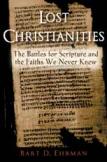A Clash of Ideas and Beliefs
What was going on in the Christian movement between the writing of the New Testament books and the Council of Nicea in A.D. 325? From well-marketed books and television programs that promise alternative visions of Christianity, it seems that in this period there was great diversity in theology and practice. But for nonspecialists, personal contact with the evidence on which the talking-head professors base their claims is hard to find. These two volumes will help.
Bart D. Ehrman, chairman of the department of religious studies at the University of North Carolina at Chapel Hill, examines noncanonical early Christian writings in order to see what they can reveal about the various forms of Christian faith and practice in the second and third centuries, and about how one early Christian group (which Ehrman calls “proto-orthodoxy”) established itself as dominant in the religion, thus determining for ages to come what Christians would believe, practice and read as Sacred Scripture.
Lost Scriptures is an anthology of translations of 43 of these texts, while Lost Christianities analyzes in detail some of the texts, discusses the groups of early Christians who produced these and other texts, considers the conflicts that arose among the groups and reflects on the strategies that proved effective in the struggles for dominance.
Most of the texts in the anthology are presented in their entirety and are arranged according to literary types: gospels, acts of the Apostles, epistles and related writings, apocalypses and revelatory treatises, and lists of canonical books. They include Christian apocrypha, the Nag Hammadi documents and the apostolic fathers. Almost half of them were translated by Ehrman, and the rest are taken from other existing collections. Each text is provided with a brief introduction. Thus, Lost Scriptures offers the reader first-hand acquaintance with the texts treated in the other volume. On the whole, it provides a good sample of the literature and illustrates nicely the complex and often exotic world of second- and third-century Christianity.
Lost Christianities presents analyses of individual texts in their historical context. Ehrman displays expert knowledge of the texts and the best modern scholarship, as well as sound critical judgment about their content. His balanced exposition of the Gospel of Thomas, with its careful delineation of the different materials in it, is outstanding. His essay on the Secret Gospel of Mark, with its suggestion that the text may be a modern forgery (perhaps even by its learned editor, Morton Smith), reads like a detective story. Studying a text in the anthology and reading Ehrman’s discussion of it can be both informative and engrossing.
One of Ehrman’s goals is to update Walter Bauer’s Orthodoxy and Heresy in Earliest Christianity, which appeared in German in 1934 and in English in 1971. Bauer’s thesis was that beliefs that later came to be accepted as orthodox or heretical were originally competing interpretations of Christianity, and that the groups that held them were scattered through the Roman Empire. What came to be regarded as orthodoxy was one form of Christianity, whose geographical center was in Rome. Thus Bauer sought to overturn Eusebius of Caesarea’s model of an original orthodoxy going back to Jesus and the Apostles, from which various heretics deviated through the centuries.
Subsequent to the discovery of the Nag Hammadi documents in Egypt in 1945 and the intense research done on them and on the early Christian apocrypha and related texts, there is now more material to be fitted into Bauer’s model of early Christian history. The texts presented in Ehrman’s anthology and his incisive analyses of them constitute a solid contribution to showing the diversity of thought and practice within early Christianity. Ehrman also suggests that early Christianity was even less tidy and more diversified than Bauer realized.
My major problem comes with Ehrman’s concept of “proto-orthodoxy.” He regards proto-orthodoxy as one of the many competing interpretations of Christianity in the early church. He claims that all forms of modern Christianity—Catholicism, Orthodoxy and Protestantism—go back to this one form of Christianity that emerged victorious from the conflicts of the second and third centuries. He contends that Bauer underestimated the effect of proto-orthodoxy throughout the Roman Empire and overestimated the influence of the Roman church on the course of the conflicts.
The problem is that Ehrman’s “proto-orthodoxy” appears as some vast and amorphous conspiracy that is everywhere and can include and explain almost everything. Its representatives are many and varied, most of whom look very good to me in comparison with their more exotic and adventurous fellow Christians. But in referring to “proto-orthodoxy,” Ehrman frequently uses negative and loaded terms like “machinations,” “quest for dominance,” “falsifications” and “intolerance.” While he does not necessarily dislike proto-orthodoxy, he seems to be deeply suspicious of it.
The truth about the historical emergence of the “great church” and Christian “orthodoxy” probably lies somewhere between Bauer’s narrow focus on the triumph of the Roman church and Ehrman’s idea of a vast proto-orthodox movement. While the history of this development is likely more complicated and less conspiratorial than Ehrman’s model indicates, his two volumes do allow readers to work through the textual evidence and make up their own minds about it.
This article also appeared in print, under the headline “A Clash of Ideas and Beliefs,” in the December 22, 2003, issue.








